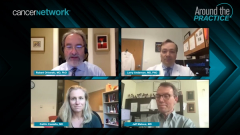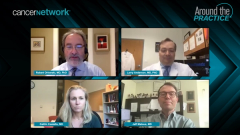
Frequency of Measuring Treatment Response in MM
Recommendations for measuring treatment response in patients with multiple myeloma utilizing tests such as MRD assessments.
Episodes in this series

Robert Orlowski, MD, PhD: The last topic in the discussion for this section is about treatment response and how it’s defined and measured. We’ve covered a lot of that ground already. Larry, how frequently do you check response? Do you check every cycle? Do you check every 2 cycles? Do you ever peak early and look halfway into a cycle?
Larry Anderson, MD, PhD: Yes, all the above, but usually I’ll check once per cycle. If someone is rapidly progressing or has aggressive disease and you want to make sure they’re responding, I’ll check it in the middle of a cycle to make sure we don’t need to switch gears, but usually once a month for most of these patients.
Robert Orlowski, MD, PhD: Jeff, we’re going to talk a little about MRD [minimal residual disease] later. But out of curiosity, are you using any of the MRD tests in the middle of therapy? For example, some people can send blood to the Mayo [Clinic] to do the mass fixed test where you look at the monoclonal protein by mass spec and not just electrophoresis.
Jeff Matous, MD: Bob, I’m still in my own head trying to get my arms around what to do with MRD information. It’s 1 of those things in which we know it’s good to be MRD negative in a sustained fashion, but do we know what to do with patients who don’t obtain MRD negativity? I struggle with that. Certainly, in my younger patients, the phrase I use is…curative intent. I do MRD, so in those patients, I get baseline marrows. I do clonoSEQ in my younger patients. Then after a transplant, a lot of times we have confidence in our flow for looking for MRD by flow cytometry. But I always caution my patients because I’ve had patients ask me about MRD. I’ve had patients come in and say, “I want to be MRD negative.” Great, let’s talk about that. I always tell them that I don’t often know what to do with the information.” In my younger patients, I tend to do clonoSEQ, and we use a lot of flow for MRD. I haven’t done a lot of MRD testing in my more infirm patients, as Larry referred to. But going back to the group of patients to whom Larry referred, those patients might be more vigorous but defer transplant. In those patients I do tend to do a little more MRD testing just to see where we are. I’m confused about MRD a little and how to use it.
Robert Orlowski, MD, PhD: Caitlin, what are your thoughts? Can you clarify some of the confusion for Jeff and the rest of us?
Caitlin Costello, MD: Sort of, Jeff, but you’re confused because there’s nobody. Every trial nowadays has MRD as an end point, and we’re waiting for those end points. We’re seeing more and more that MRD has a role, but you asked the question of what to do if you’re not MRD negative. Let’s pose the opposite question of what if you are. We don’t have an answer for that either. Does that mean we can use therapy? Don’t know. If you’re MRD negative, does that mean you’ve done it and you’re done? Or if you’re MRD positive, do we have to push harder? There are no good answers. This is a “Do as I say, not as I do” situation. We all talk about checking it—we need to know—but I don’t do it all the time because I don’t know what to do with it. Outside a clinical trial and particularly for our community oncology colleagues, I’m not sure it’s practical or realistic to have a role in clinical care.
Robert Orlowski, MD, PhD: Hopefully, in the future, we’ll have blood-based MRD testing, so that will make it easier on patients. We won’t have to do bone marrows.
Transcript edited for clarity.
Newsletter
Stay up to date on recent advances in the multidisciplinary approach to cancer.





















































































